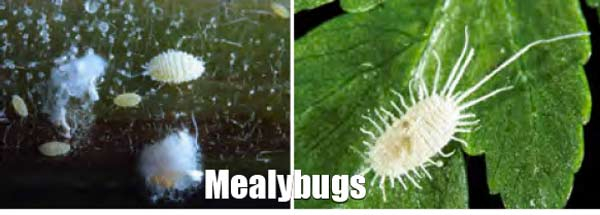Mealybugs are sap-sucking insects that will feed on a wide range of tree crops. They can shelter in the calyx of pome fruits and are a pest of concern for export markets.
Pest identification
Female adult mealybugs are around 3 mm long, oval-shaped and usually covered in a white waxy coating (see images above). Males are usually small aphid-like winged insects.
When squashed, mealybugs secrete a pale yellow liquid.
Mealybug nymphs hatch from eggs within the female and are born live. They are small and orange-brown.
Longtailed mealybugs can be distinguished by their long tail filaments that can be as long as, or longer than, their body (see above right).
Damage
Mealybugs cause damage by inserting their mouthparts directly into the plants.
Infested plant parts may be spotted, curled or wilted.
They also secrete a honeydew sap that encourages sooty mould growth, downgrading fruit quality. In severe infestations, tree health can be greatly reduced.
Monitoring
Fortnightly monitoring is important during the growing season.
Look in the calyx of developing fruit during harvest at weekly intervals and record any mealybug presence.
During dormancy, check under bark or other sheltered places for overwintering larvae or adults.
While monitoring for mealybugs, keep an eye out for ant activity to determine if additional management measures are required. If ants are present, try to identify the location of their nests.
Physically destroying ant nests in the orchard will reduce the number of ants that are protecting and spreading the mealybugs, rendering it more vulnerable to predation by beneficial insects.
Management
Cultural and physical
Good orchard hygiene is critical for mealybug control.
Infested material should not be used as mulch, but should be removed from the field and destroyed. Mealybug infestations are worse on dusty trees, thus you should avoid vehicle movement near trees on the windward side of infested blocks and where possible, wet tracks down regularly.
Biological
Several biological controls are available for mealybugs including various lady beetles, lacewings and specific wasp parasites (see left).
Wasps can be extremely effective as they are highly mobile and efficient at seeking out their prey.
Download the Orchard plant protection guide 2020-21
See this article in Tree Fruit April 2021




















